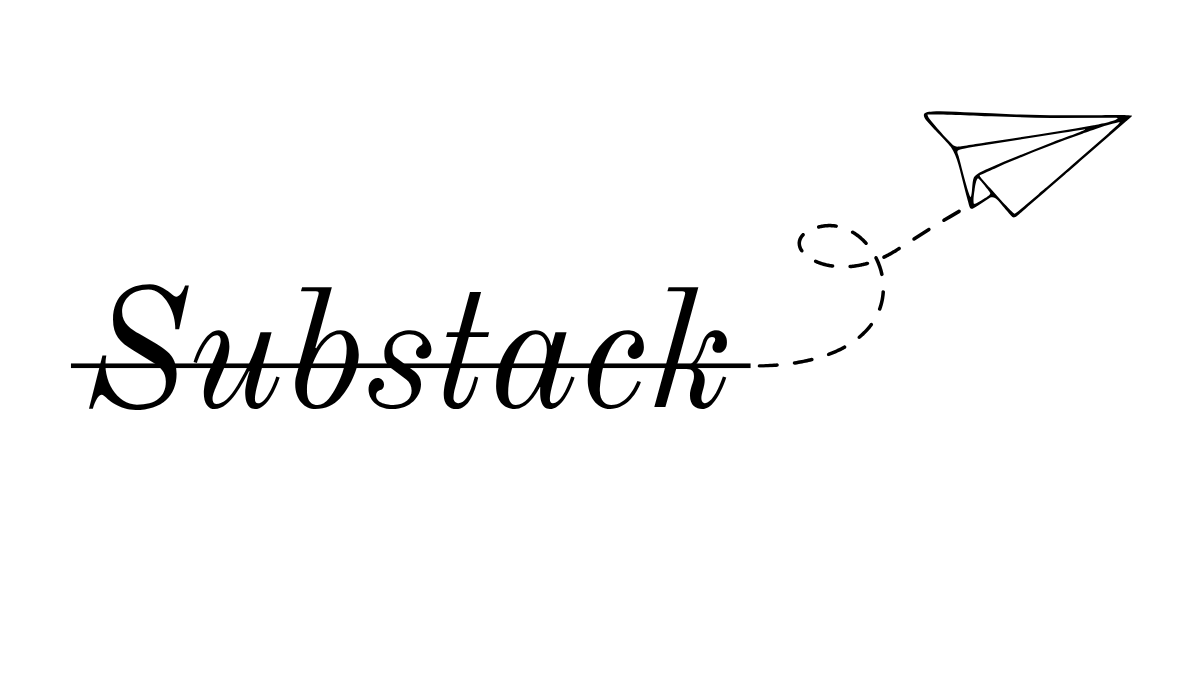
Don't Start Another Substack
When we started New Feeling in 2020, it came out of wanting to respond to the structural issues we were facing as journalists at the time: namely the dwindling employment and work opportunities mixed with an abundance of incredible music in the country to write about— more than anyone really thought would be available considering how quickly the world ground to a halt. Both journalists and musicians were hit hard by the pandemic and lockdown, and it seemed like the right moment to experiment with something new. I won’t ever forget how quickly it felt like everything came crashing down all at once. One week in February I had been offered to write a regular column for a magazine that was launching in Toronto, and by early March the entire operation was shuttered. I wasn’t alone. Freelance budgets froze overnight. Waves of layoffs followed. I saw so many colleagues scrambling for a safe place to land, with many of them turning to platforms like Substack to try and make some money from their work.
Though it was exciting to see so many people take off to do their own thing, the response seemed more like a band-aid than any real solution. On a practical level, I ain’t reading all that. I was barely reading the newsletters I had already subscribed to, there was no way I would possibly keep up with newsletters from every single one of my peers regardless of how much I enjoy and value their work. Fundamentally, I could see journalists who had previously worked on teams with editors or in newsrooms now suddenly alone and unmoored. In the years since, and especially as this platformization of media has continued, I’ve continued to think about how easily anyone can start their own newsletter with just a few clicks, and what that ease says about how these platforms work and who ultimately benefits. It’s become increasingly clear that platforms like Substack don’t simply offer writers the choice of independence but actively push workers toward individualized, entrepreneurial survival strategies at the expense of solidarity and collective action.
In Canada’s traditional newsroom model, journalists work inside organizations with dedicated editors, copy desks, fact-checkers, photo/video teams, and resources like institutional memory, legal counsel and training— capacities that enable collaborative, public-interest reporting but also impose editorial standards and beats, not to mention labour protections if the workforce is also unionized. These shops pool their reputational capital and distribute work across an entire staff, they can shoulder greater risk in the form of longer investigations and Access to Information and Privacy (ATIP) requests, and navigate legal threats.
The newsletter economy contrastingly atomizes that work by providing frictionless offramps into individualized hustles. The solo writer becomes their own publisher, marketer, community manager, and business office, trading benefits and job security for autonomy, speed, and direct subscriber revenue. These initiatives are more agile than large newsrooms and publications, but become much more vulnerable to platform terms and conditions, subscriber churn, and burnout because they concentrate their efforts in personal brands and parasocial ties and lose the benefits that typically come from being an employee, even though platforms like Substack skim 10% of their revenue off the top.
Over the past 25 years, staff jobs in Canadian print media have been on the decline. In 2017 the Canada Public Policy Forum estimated 12,000 jobs in the news media sector were cut over the last few decades, while the last Canadian census showed that the number of employed journalists dropped by 9.6% between 2001 and 2017. Statistics Canada's definition of "journalist" didn't include editors or photojournalists though, so these numbers only offer a segment of the total ongoing losses. More recently, Postmedia announced cuts of 11% of its editorial staff, plus around 75 jobs with the sale and closure of its Windsor Star press plant. That same year, Metroland ended print at around 70 community newspapers and eliminated 605 jobs. Unifor, Canada’s largest private sector union, confirmed at least 104 of those were unionized positions that it represented. Toronto Metropolitan University’s Local News Research Project, which tracks the opening and closures of local news outlets shows an ongoing wave of community-newspaper closures. Between 2008 and June 2025, a total of 571 news outlets were closed, about 33 per year, with 74% of those being community news. By October, that total had reached 603 closures, a 5.6% increase in less than six months.
These closures and layoffs are happening amidst widespread media consolidation, an intensifying process in the digital age. The Canadian Media Concentration Research Project (now part of the Global Media and Internet Concentration Project) published a report in 2022, called Media and Internet Concentration in Canada, 1984–2021 detailing these struggles across all media in the country. The report indicates news media’s declining commercial prospects have magnified their dependence on digital platforms like Google, Facebook, and Apple for distribution, as they’ve become the primary access pathways for readers, technology, and billing systems, as well as for direct payments. Those same platforms are also chewing up the vast majority of advertising dollars in the market, money that print media previously relied upon to sustain itself. Collectively, Google, Meta, and Amazon control nearly 90% of all online advertising, according to the report. When Meta permanently ended news availability in Canada across platforms like Facebook and Instagram in response to the Online News Act in 2023, it completely shut media outlets off from referral traffic and related ad revenues. Meanwhile, Meta’s user activity in Canada barely changed, but the composition of what people saw shifted away from professional news toward other content, paving the way for large language models like ChatGPT, Meta’s AI, Google’s Gemini AI, and platforms like Substack to fill the void. In a recent piece written about Stereogum’s relaunch on the same worker-owned platform that’s behind Defector, founder Scott Lapatine wrote that “Google's pivot to AI search has cut our ad revenue by 70%.”
As remaining traditional newsrooms struggle to meet the performance metrics imposed on them by their vulture capitalist owners and navigate the total lack of ad dollars coming their way, these institutions have turned increasingly to freelance and contract work as a way to satisfy those performance targets while contending with layoffs and chronically underfunded newsrooms. As the Canadian Association of Journalists reports in their 2024 Newsroom Diversity Survey, “more and more journalists are moving to freelance work,” though it's difficult to arrive at a reliable count for how many freelancers there are in the country because many outlets rely on the same pool of freelancers and double-counting would likely occur. Unifor's media policy brief from 2023 similarly describes a rapid growth of freelancing in Canada. Overall, industry cost-cutting has produced greater precarity and instability for workers. As Victor Pickard observes in his 2020 book, Democracy Without Journalism?: Confronting the Misinformation Society, these issues disproportionately affect women and people of color. The aforementioned CAJ diversity survey also confirms this: both women and Black journalists are more likely to work part-time than full-time or supervisor roles. While Pickard also notes a rise in unionization among digital journalists, the overall trend points to journalism becoming a deeply precarious form of work. This growing precarity underscores exactly why it’s so important for journalists to be thinking about our labour, and the long-term effects these platforms have on our ability to connect and see each other as more than just our audience, subscribers, or competition.
The decay of public-interest media and the subsequent disappearance of staff positions have created a vulnerability for both readers and writers, forcing them toward platforms that promise individual monetization as a solution to this growing labour question. Substack in particular has thrived in this vacuum. It launched in 2017 and quickly reached success in 2020 during the first wave of lockdown layoffs, offering a turnkey substitute for the distribution, billing, and audience access newsrooms lost to tech companies. Writers plug into Substack’s payments, email deliverability, discovery tools, and cross-promotion network, then monetize readers directly. That’s the logic of platformization: activities once handled by institutions (like taxi cabs in the case of Uber, or hotels in the case of AirBNB) are re-intermediated by a private platform that sets the rules, takes a cut, and owns the data. And it’s vulnerable to what Cory Doctorow named “enshittification:” initially offering generous terms to lure users, then tilting services toward paying customers with features and discovery that reward already-famous newsletters and high-conversion content, and eventually optimizing for the platform’s own extraction with additional fees, frictions that make leaving costly even if you can export your mailing list (like Substack’s own self-contained social media platform Notes), and design and ranking systems that steer reader attention toward certain creators and behaviours.
Substack works very hard to paint its public image in a more positive light, marketing its services as a kind of freedom: “the app for independent voices.” But here, “freedom” is defined as self-entrepreneurship, not collective power. Labour is a personal brand, not collective work. As writer Anil Dash pointed out last year, writers have quickly taken to calling their own work by Substack's name (“I have a new Substack out this week”), a choice of metonym which is very revealing in how it centres the platform over the writer, especially when we already have language like “blog” or “newsletter” to describe the function of a service like Substack.
But “subscribe to my Substack” communicates so much more than “subscribe to my newsletter,” indicating you’re part of a particular emerging creator economy, a league of independent voices who’ve managed to carve out space for themselves in this hellscape of an industry, and actually found a way to monetize their writing. The word “Substack” has quickly become an identity shorthand for writers wishing to set themselves apart and align their work with a platform experiencing runaway success. This shift is a part of a larger trend within platformization that further abstracts labour. Substack corporate literature doesn’t refer to its user base as writers, but as “creators.” Elsewhere, “creators” have found similar homes on platforms like Patreon and TikTok, using those platforms and their services to build audiences and brands.
In breaking down barriers between professions, the “creator economy” could be a real boon to building a labour movement for precarious workers in creative fields, but the way it's invoked by these platforms suggests something much more uncomfortable and problematic. Calling user bases “creators” frames individual output as product and producer as micro-business. This shifts responsibility and risk onto individuals rather than platforms or employers. Uber's longstanding refusal to acknowledge the drivers making its app and service possible as their own employees is emblematic of how these platforms are working to mask employment relationships as they “disrupt” the economy. Insisting upon this “creator” label helps to weaken access to benefits, due process, and collective bargaining under traditional and distinct skillsets that belong to writers, editors, photographers, and journalists, aligning with a worldview that values monopolization and self-reliance over solidarity.
It’s a net good when people are able to build networks outside of mainstream media. I would not be the journalist I am today if I hadn’t been able to leverage platforms like tumblr and Twitter to publish and share my work before any legitimate publications were reading my pitches, much less accepting them. But, even though I’ve benefitted from it, I am also seeing the long-term harms of platforms being naturalized or trusted in publishing spaces, and it's vital to remember the role such platforms are playing in helping create the precarious conditions of our field to begin with. Tumblr went through widespread NSFW content moderation overnight that forced users to leave it and the communities they had formed in droves. We’ve all seen what Elon Musk has done to the platform since taking over Twitter and turning it into a cesspool of right-wing ideology and hate, hemorrhaging its value as well as its users. Substack is already enabling and profiting from its own “reactionary centrism” that leaves the big tent open to hatred of all kinds.
Substack alternatives like beehiiv crop up every day, and there will always be another gleaming platform to hop to next when the current one fails. But for things to change, we have to imagine more than hermit crabbing from one platform to the next: we have to resist the ways our work is becoming individualized in the first place. It is structurally easier to establish an individual micro-enterprise in just a matter of clicks because that’s how platform capitalism is designed. Modern platforms simplify the initial effort required for independent users while making the transaction costs of coordination invisible. Collective production, by contrast, requires visible governance, shared risk, and interoperable infrastructure, all capacities that have been systematically under-supported by venture capital logics. While the tools that make it absurdly easy to “go solo” also make it harder to imagine, let alone practise, doing the work together, more writers are combining efforts to resist precarity and the systems that breed it.
“The network effect that they've created, which is so appealing to people, it's a desire for autonomy,” explains Paolo Mirello, co-founder and secretary-treasurer of French Canadian media cooperative Pivot. “It's a desire for something where they don't have to coordinate with anybody because of course, in a cooperative to make it work, there's all these coordination costs. It might seem simpler for people to just do their own thing.”
Pivot emerged when the francophone side of Ricochet Media merged with Majeur, a newly formed co-op designed to take advantage of fresh federal journalism tax credits so journalists could be salaried. In the merger, the co-op effectively absorbed Ricochet’s francophone non-profit, creating a new newsroom under the Pivot banner in 2021. Founders from both groups consolidated around a cooperative model thanks to Quebec’s supportive ecosystem for cooperatives.
What sets Pivot apart is its solidarity co-op structure, Quebec’s terminology for “multi-stakeholder,” and its explicit guardrails for editorial autonomy. Their rules state the board does not influence newsroom work, and as a non-profit they’re not pursuing private enrichment, choices that Mirello frames as structural answers to Canada’s media crisis.
Politically, Pivot is openly progressive and rejects the journalistic convention of the “appearance of neutrality.” Instead, they argue that being clear about their editorial line while maintaining rigorous, factual reporting is more honest than pretending to be neutral. “Of course there are biases because we do cover things in a certain way,” Mirello says. “But that doesn't prevent us from being factual or rigorous, or from looking for the truth. So we might as well be open about it.” They also push back on the “activist media” label that’s been leveled against them as a kind of pejorative, noting they aren’t an instrument of a political party or movement but cover social movements and progressive concerns with standard journalistic methods that are buoyed by the cooperative model.
Working cooperatively in a non-hierarchical structure doesn’t just affect the quality of their reporting, it also shapes how they work. “We realized we have the capacity and enough people that we could technically cover daily news,” Mirello explains. “But to really dig into a story and do the kind of journalism that we want, we shifted toward slower, more in-depth reporting. It’s better for everyone, and it lets us resist the click-bait-y, ‘get the news out as fast as possible’ pace of traditional journalism.”
Platform logics have restructured journalistic labour, isolating workers and turning public-interest reporting into a set of solo hustles. Substack and similar services expanded because layoffs and consolidation created a vacuum. What appeared to be freedom often isolated workers with the same risks and bills that newsrooms once shared. The offramps to individualized hustles that dominate today are not neutral or inevitable, they are a deliberate design choice by capitalist platforms that present coordination as friction and independence as efficiency. Sign-up flows and billing tools make going solo feel effortless, while the real costs of collective work remain hidden. This is structural and intentional, not fate.
If platforms push us toward individualized survival, we can refuse that horizon. We can rebuild capacities that make journalism durable. Editing, fact-checking, legal support, beats, mentorship and labour protections can exist outside legacy conglomerates. Pivot’s solidarity cooperative offers a working example. Prioritizing values and worker autonomy can protect editorial autonomy. Prioritizing slower, more in-depth reporting creates a healthier pace that leads to improved journalistic quality and also helps to insulate writers from burnout.
New platforms will continue to promise easier distribution and better discovery. They can exist without defining what the future of journalism looks like. It’s possible to build better conditions together that do not make going it alone the easiest and best choice outside of mainstream media. While platforms have given us the opportunity to monetize our work, we should be thinking about how we organize our work. Together we can carry risk, slow down enough to be rigorous, and hold fast to solidarity.
Read more

Sentries: Multifaceted Noise Rock

Step Into Little Stone Crow's World

